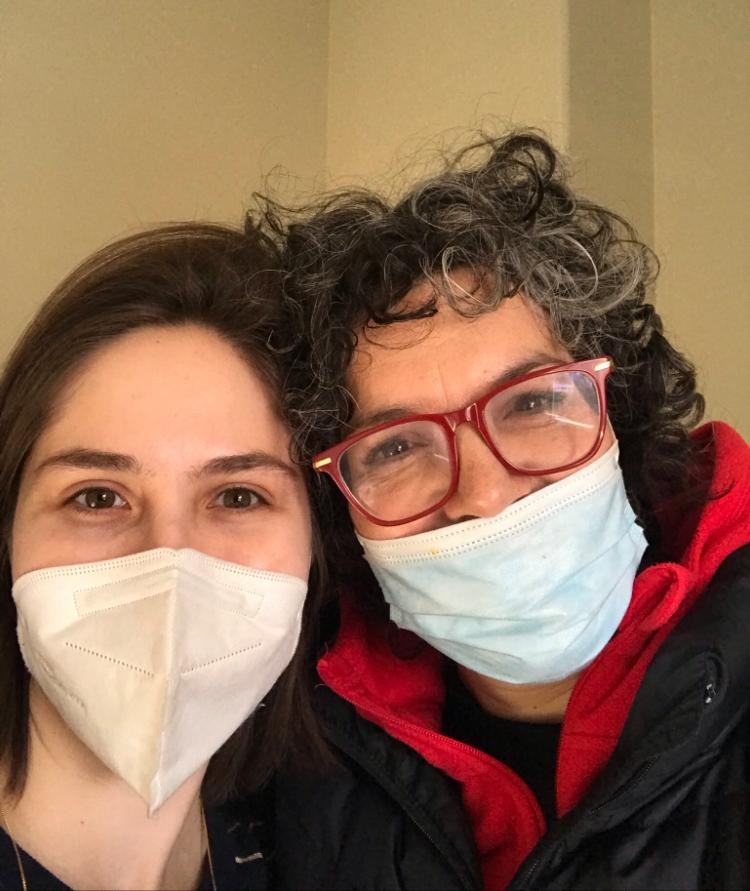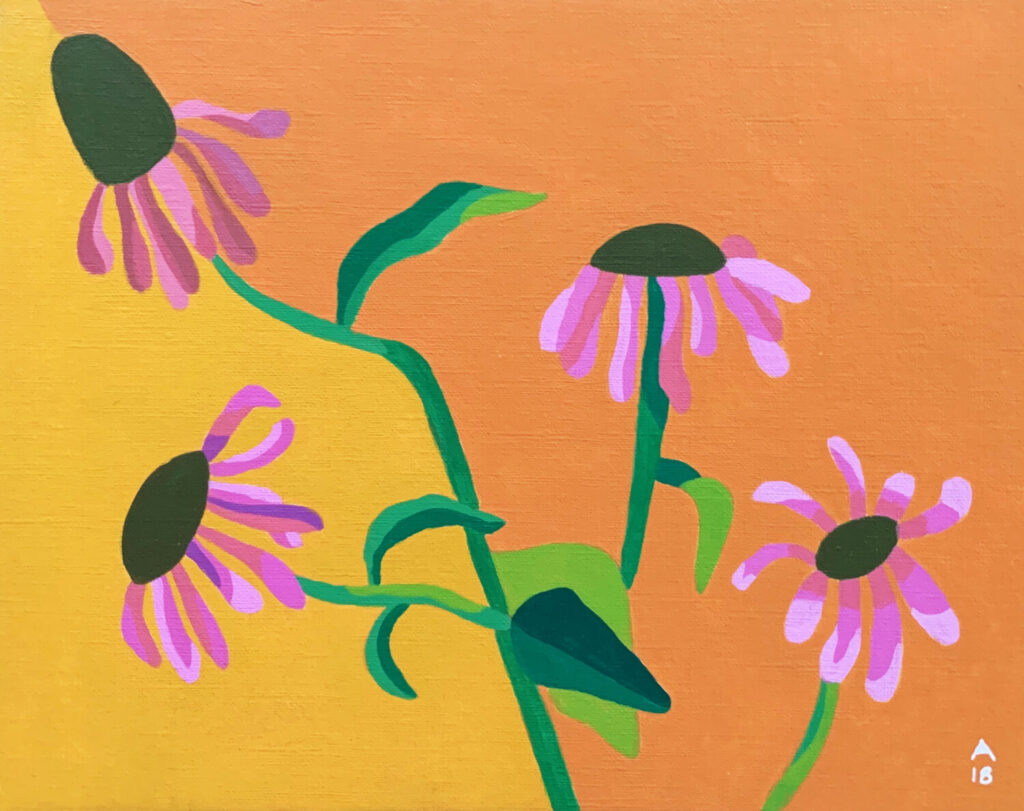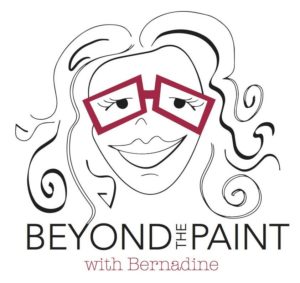Journey with me through the flat planes, shapes and curvaceous edges bursting with vivid colors in the works by contemporary Brazilian artist Ariana Tavares. Works highlighted include the painting, “Monstera,” from her Tropical series and includes an insightful conversation with the artist. Below is a photo from a recent visit I had with Ariana in her Brooklyn studio.


Resources for this podcast include Ariana Tavares website, Tate Museum, The Art Story, Create Magazine, New York Times and writers David Salle and Claire Cain Miller. I encourage you to follow Ariana Instagram, her handle is @arianact.
Script: Welcome to Episode 106: Ariana Tavares: Nature: Up Close
This podcast series is anchored by women and their work as artists and makers. Beyond the Paint is a labor of love. My vision for this series is to share with you all the ways women impact the visual art world but more importantly how they can shape your ways of seeing the visual world. Before I met the women, there were the men. In the story of Western art–Western art encompasses the art of western Europe or visual expressions that have their roots in Europe– men fit prominently as the artistic visionaries through its canon of works. I embraced each of those men with vigor in my studies in Art History when I was an undergraduate student and graduate student. To be honest, I was ok that women worked in their shadows. Women’s mark on art history’s timeline is faint compared to the masters of art, the men. I did not question, even for a moment, the sanctity of this patriarchal viewpoint. I believed with abandon the story presented in texts and museum collections was the singular truth. That singular truth has shifted as the world of art opened up to be more inclusive of underrepresented artists: women, non-binary artists and artists of color –certainly globalization has challenged our notions of what constitutes Western Art. In no way is it my intention to persuade you to eliminate the impact of male artists, pioneers of art movements in the story of art–they continue for me to be a springboard to the women artists I embrace.
I note this in part because of the woman artist I celebrate in this episode, Brazilian painter Ariana Tavares. An architect, she explores a variety of media including paint and the modern technology of the IPad to create engaging works focused on shapes and forms defined through vivid colors. As we dive into her work and practice, I want to share two male artists that came to mind whose style she also adopts in her work: Alex Katz and David Hockney.
This episode includes a conversation with the artist. I had the privilege to visit Ariana in her Brooklyn studio, small intimate room with a table set again a curtain-less window allowing light to freely flow through. Near her table are books about varying areas of art on a white shelf and pinned on a board, postcard sized prints from artists she knows including Laurence de Valmy (our mutual friend–I featured her in episode 89). When I visited she had some smaller paintings spread out on the desk; close up views of flowers and leaves. She told me she brings to the canvas what she experiences, sometimes from her walks in her neighborhood. There is also an easel displaying one of her more recent works, part of her tropical series.
Her work reminds me of the 20th century painter Alex Katz–Hi s art, composed of flat fields of color and clean lines, as Katz claimed, is about “surface.” His imagery is not particularly psychologically complex. (art story) For example, the 1963 painting “Red Smile,” is a large scale work of a portrait of a white woman in profile wearing bright red lipstick exposing her teeth. The background is a sheet of bright red similar to the red hue of her lips. There is little trace of the work’s making, no visible brushstrokes–the colors are flat and saturated or dense. What is fascinating is the way he puts the colors together– they create a “powerful chain of response from eye to brain.” What writer David Salle describes as the intervals between colors.
Everything is form “we recognize it as such when it’s divided into shapes, or planes of different colors. where two forms meet there is the edge; Salle claims, “How a painter treats this edge is the real subject of realist painting; how the brush behaves in the vicinity of an edge gives paintings its present-tenseness, the feeling of the eternal present. Katz is a master of the edge declared art critic John Russell.
In Ariana’s painting compositions of flat planes and shapes, her edges, distinct are less clean, they are softer, more curvaceous. She paints forms of objects she is drawn to, many are found in nature like plants and flowers; each form is a pool of one vivid color with splashes of hues or secondary colors, delineated by it edges. In the work “Monstera,” a large tropical American climbing plant distinguished by its perforated leaves, Ariana composes a solitary leaf, it dominates the canvas atop a bright, solid, purple background. The surface texture of the leaf is distinguished through varying shades of greens and yellowish greens, the veins flow like a river in lighter shades of green. It created for me a sense of enchantment with an what seemingly appears to be an ordinary leaf.
Ariana told me during my visit that the background is, “solid color that contrasts with the object” this choice helps to emphasize and bring our attention to the object, mostly from nature, like a leaf or flower. She says, “I think of the composition, how the image will fit on the surface–work with one main object using shape and color to give it attention and power.”
Create magazine, who featured Ariana claimed, “she has been inspired by colors and shapes from Brazil’s countryside landscape and natural features. This is strongly present in her art coupled with her growing awareness of urban landscape, culture, and the cities’ diverse forms she experiences in her current home in Brooklyn and throughout New York City.” She shared with me that her trips to botanical gardens, parks are a source for her paintings. What is so interesting to me is how she sees and expresses vast gardens or a groupings of flowering shrubs. She chooses from the masses of flowers and leaves, one leaf or perhaps one or a few petals from a single flower and onto the canvas, she expresses its details, its bursting colors, the form of the leaf or petal is defined not by line, but by the edges the art critic Salle spoke of. Deep emerald green is a fluid as it meets up with a medium-toned green, our eye moves from those dense colors to its edges or organic forms. And in her whimsy, sometimes the solid colors are interrupted by dots or a splash of varying tones atop the dominant green, or perhaps light brown.
Her tropical plants are wonderful, visually delicious, but there is also her portraits. In her studio she had three portraits of women propped up against one wall. Here too she explores color building up the facial features, high cheek bones or dominant chin, the waves of hair through juxtapositions of flat colors. (Katz book) The pinks, the tans, the flesh tones, the yellows, the brown and blacks form, what Salle refers to as “assertive counterpoints to the jump the eye takes from the dark hair, to the peachy tones of the model’s forehead to her bright pink lips pressed together. The beauty of her subjects distilled in those flat planes of color delineated by the edges of each form.
In our chat at her studio, Ariana shared her desire to explore different media, including technologies like the IPad. In my conversation with Ariana in a few moments, we discuss this further, but I want to give you some perspective through the contemporary artist David Hockney. I pulled a brief biography from the Tate Museum. Hockney is a British born artist who “created a career of breaking taboos and leading the avant-garde as an important contributor to the pop art movement of the 1960s, he is considered one of the most influential British artists of the 20th century.”
One of the reasons I am so fascinated about him is embrace of digital works through an IPAD and stylus pen. Hockney said, “There was a great advantage in this medium because it’s backlit and I could draw in the dark. I didn’t ever have to get out of bed.” From his bed, Hockney made a collection of IPAD drawings of the view from his bedroom window in Bridlington, East Yorkshire; he created this series between 2009 and 2012. ” From this viewpoint, from his bed to the window, we see what Hockney sees: the sunrise, for example, and more importantly, the way Hockney feels it; From the work, “Untitled 470,” he expresses through a range of colors against a blue sky, streaks of deep pink melding into streaks of yellow and peach tones. These brushing streaks of colors are framed by the window, and on its ledge a plant, abstracted stem and leaves, flowers rising, their petals closed up into a ball-shaped form.
Hockney says the IPad and stylus have simplified the process of painting and thinks the medium is here to stay. From the New York Times article, Claire Cain Miller observed, “Mr. Hockney has long been interested in the technology of art and using new media to make art. He wrote a book about evidence that the old masters used devices liked a camera lucida. He has used Polaroid film, color photocopiers and fax machines, and in 2009, began sending friends daily drawings of flower bouquets made on his iPhone.”
“People from the village would come up and tease me: ‘We hear you’ve started drawing on your telephone,’” Mr. Hockney said. “And I tell them, ‘Well, no, actually, it’s just that occasionally I speak on my sketch pad.’” The hierarchy within the traditions of art and art history are relegated to painting and sculpture and here through artists like David Hockney, we experience the intersection between art and technology. The IPad becomes the canvas. Let’s hear from the perspective of this episode’s celebrated artist– Ariana Tavares; her process, her works, her choice of media, the way she draws you in to see more intimately objects in nature—Now my conversation with Ariana Tavares.
